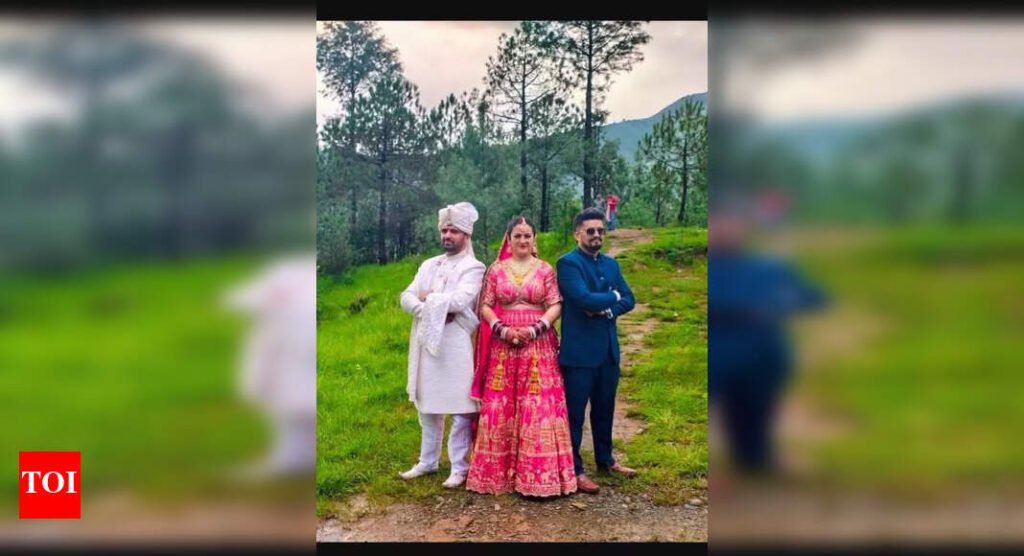Kullu: Embracing their age-old polyandry custom, two brothers and a woman from the Haati community have entered a wedlock in the remote trans-Giri region of Sirmaur district in Himachal Pradesh — a rarity for being openly celebrated, and special for giving the woman the freedom to choose which husband she’ll live with. Brothers Pradeep Negi and Kapil Negi married Sunita Chauhan, a resident of Kunhat, in Shillai village of Sirmaur district in a three-day function that concluded on July 14. Hundreds of villagers and relatives witnessed the marriage ceremony and participated in the function, which concluded with Pradeep, Kapil, and Sunita taking to the wedding stage and dancing together to traditional folk songs as village elders blessed the throuple.While Pradeep is employed with the Jal Shakti department, Kapil works abroad in the hospitality sector. Sunita has completed her training from an Industrial Training Institute (ITI). “It’s a moment of great joy for all the Haati community members. We are feeling proud because our educated youth are not only keeping our old traditions alive but also setting an example. There are many such secretive marriages in our community, but these three youngsters created history by marrying publicly,” said Hira Singh, a relative of the grooms.“The decision to marry was taken by the grooms and the bride together. It was their collective wish, and no one was forced to do anything,” Singh added.The Giri river divides Sirmaur district into two almost equal parts. The Haatis mostly live in 154 panchayats of the five tehsils of the trans-Giri region — Shillai, Sangrah, Kamrau, Rajgarh, Nohradhar, and the two sub-tehsils of Ronahat and Pajohta.Known for their distinctive culture and unique traditions, the Haatis number around three lakh in Sirmaur district, and a total of 14 castes — including the Scheduled Castes, OBCs, and the general category — are part of the community.According to Amichand Kamal, the president of the Kendriya Haati Samiti (KHS), which led a successful decade-long campaign to get the Scheduled Tribe (ST) status for the Haati community, the polyandry custom is practised mainly to prevent land division.“Polyandry was a norm in tribal societies, including the Haati community, as it prevented the fragmentation of ancestral land and stopped widowhood. Also, a woman enjoys more freedom under this custom as she can choose her husbands as well as leave them without anybody questioning her decision,” said Kamal.He further said polyandry was not rare, but the number of such marriages had dropped significantly. “Polyandry is a socially acceptable custom in the Haati community, and though primitive, such matrimonial alliances are perfectly legal in tribal societies. The number of such alliances has come down over the centuries, but it’s not a rare phenomenon as people still marry but maintain secrecy,” said Kamal.Polyandry was also prevalent in Lahaul Spiti and Kinnaur, but over the last few decades, such marriages have become extremely rare in these two tribal districts.“The custom of polyandry has almost ended in Lahaul Spiti and Kinnaur, mainly due to the rise of nuclear families and people’s migration from tribal areas to neighbouring districts. There has also been a gradual shift from agriculture to the service sector in these two districts,” said Shamsher Singh, a research scholar on folk art and a resident of Lahaul Spiti.“The custom, however, still exists, though in a very weak form in Sirmaur’s trans-Giri area and the neighbouring Jaunsar-Bawar region of Uttarakhand mainly due to a strong influence of the epic Mahabharata on their culture,” said Shamsher.“In the Haati community, there are those who believe they are the descendants of Kauravas and there are others who say Pandavas were their ancestors. This huge influence of Mahabharata, especially the marriage of the five Pandavas to Draupadi, continues to reflect in Haati customs,” he added.MSID:: 122797318 413 |


